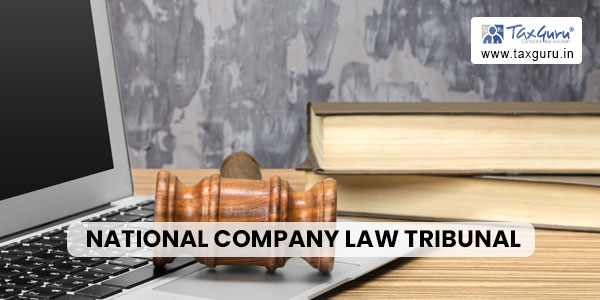Uncover the multifaceted role of the National Company Law Tribunal (NCLT) beyond debt recovery, exploring its significance in fair and efficient resolution of corporate disputes under the Insolvency and Bankruptcy Code (IBC). Delve into key provisions, court interpretations, and the NCLT’s crucial role in promoting resolution over liquidation for distressed corporate debtors. Stay informed on the evolving landscape of insolvency laws in India.
The Insolvency and Bankruptcy Code, 2016 (IBC) was enacted with the objective of consolidating and amending the laws relating to reorganisation and insolvency resolution of corporate persons, partnership firms and individuals. The IBC aims to create a time-bound and effective mechanism for maximisation of value of assets of such persons, to promote entrepreneurship, availability of credit, and balance the interests of all stakeholders.[1] The National Company Law Tribunal (NCLT) plays a crucial role in the resolution of these disputes by providing a specialized forum for the resolution of corporate disputes in a fair and efficient manner. The entire purpose of the insolvency code is resolution oriented for the corporate persons i.e. try to resolve the issues which affects financial health of the corporate persons and resolution thereof. Instead at present, the statutory provisions of the Code are being mis-utilised with the sole purpose to extract financial gain contrary to the aims and objects of the Bankruptcy Code. The present paper is a small attempt to highlight the objective of the IBC and is a further attempt to discourage any corporate persons in misutilisation of the provisions of the Code.
Sections 7 and 9 of the Insolvency and Bankruptcy Code (IBC) are crucial provisions that pertain to initiating insolvency proceedings against corporate debtors. Section 7 enables a financial creditor to initiate insolvency proceedings, while Section 9 enables an operational creditor to do so. A financial creditor is defined as any person to whom a financial debt is owed, including a person to whom such a debt has been legally assigned or transferred. An operational creditor is defined as any person to whom an operational debt is owed, including any person to whom such a debt has been legally assigned or transferred. In this paper, we restrict discussion to Section 9 of the Code only i.e. “Application for initiation of corporate insolvency resolution process by operational creditor.”
The relevant provision for the purpose of the paper is Section 9(5)(ii) which reads as follows:
“Reject the application and communicate such decision to the operational creditor and the corporate debtor, if—
(a) the application made under sub-section (2) is incomplete;
(b) there has been repayment of the unpaid operational debt;
(c) the creditor has not delivered the invoice or notice for payment to the corporate debtor;
(d) notice of dispute has been received by the operational creditor or there is a record of dispute in the information utility; or
(e) any disciplinary proceeding is pending against any proposed resolution professional.”
If we read the aforesaid provisions carefully apart from the technical requirements, a safeguard has been provided to save the company from the harsh provisions of the Insolvency Code in the form of “Notice of Dispute.” Legislature in their abundant wisdom visualised that the provisions of the Code should not be invoked at every default as the purpose is to help the company in resolving the issue and not to close the company on every trivial or contentious matter.
The word “existing dispute” has been defined in the Code in Section 5(6) which reads as follows, “ “Dispute” includes a suit or arbitration proceedings relating to—
(a) the existence of the amount of debt;
(b) the quality of goods or service; or
(c) the breach of a representation or warranty.”
The aforesaid definition is an inclusive definition[2] which must be read in widest possible connotation in consonance with the scope, aim and object of the Code. The Supreme Court clarified on the interpretation of the term “dispute” in the landmark judgement Mobilox Innovations (P) Ltd. v. Kirusa Software (P) Ltd.[3] and said that:
“54. First and foremost, the definition is an inclusive one, and we have seen that the word ‘includes’ substituted the word ‘means’ which occurred in the first Insolvency and Bankruptcy Bill. Secondly, the present is not a case of a suit or arbitration proceeding filed before receipt of notice – Section 5(6) only deals with suits or arbitration proceedings which must ‘relate to’ one of the three sub- clauses, either directly or indirectly. We have seen that a ‘dispute’ is said to exist, so long as there is a real dispute as to payment between the parties that would fall within the inclusive definition contained in Section 5(6). […].”
The Apex Court in the same case also upheld that, “51. Once the operational creditor has filed an application, which is otherwise complete, the adjudicating authority must reject the application under Section 9(5)(2)(d) if notice of dispute has been received by the operational creditor or there is a record of dispute in the information utility. It is clear that such notice must bring to the notice of the operational creditor the “existence” of a dispute or the fact that a suit or arbitration proceeding relating to a dispute is pending between the parties. Therefore, all that the adjudicating authority is to see at this stage is whether there is a plausible contention which requires further investigation and that the “dispute” is not a patently feeble legal argument or an assertion of fact unsupported by evidence. It is important to separate the grain from the chaff and to reject a spurious defence which is mere bluster. However, in doing so, the Court does not need to be satisfied that the defence is likely to succeed. The Court does not at this stage examine the merits of the dispute except to the extent indicated above. So long as a dispute truly exists in fact and is not spurious, hypothetical or illusory, the adjudicating authority has to reject the application.”

The court reiterated the stand on dismissal of application on pre-existence of a dispute in the case of Sabarmati Gas Ltd. v. Shah Alloys Ltd.[4] and said that, “Existence of a “pre-existing dispute” should entail dismissal of an application filed under Section 9 IBC at the threshold. Therefore, the question is whether the respondent had raised a dispute describable as a “pre-existing dispute” so as to entail dismissal of application of the appellant under Section 9 IBC.”
The National Company Law Tribunal, Jaipur Bench, in the case of Narayan Organics Private Limited vs. Prayag Polytech Private Limited[5], has held that an application under Section 9 of IBC must satisfy the test laid down by the Supreme Court in S.S. Engineers vs. Hindustan Petroleum Corporation Ltd. & Ors.[6], wherein it was held that creditors can only trigger Corporate Insolvency Resolution Process (‘CIRP’) ‘when there is an undisputed debt and a default in payment thereof’.[7]
The NCLT, exercising powers under Section 9 of IBC, is not a debt collection forum. The IBC tackles and/or deals with insolvency and bankruptcy. It is not the object of the IBC that CIRP should be initiated to penalize solvent companies for non-payment of disputed dues claimed by a creditor.[8]
In March 2020, the government issued a notification[9] raising the threshold limit from one lakh rupees to one crore rupees for initiating insolvency proceedings under the IBC only to strengthen the aims and objectives of the Code. This move was aimed at providing relief and protecting the interests of micro, small, and medium enterprises (MSMEs), especially during the COVID-19 pandemic. The higher threshold limit ensured that only larger defaulters were subject to the insolvency process, while smaller businesses had time to recover from the pandemic’s economic impact. This move aligns with the IBC’s objective to ensure the timely and effective resolution of insolvency matters without unduly burdening struggling businesses and helping them stay afloat.
The preamble of the Code aims to promote resolution over liquidation. The first objective is ‘resolution’. The second objective is maximization of the value of assets of the ‘Corporate Debtor’ and the third objective is ‘promoting entrepreneurship, availability of credit and balancing the interests’. This objective of the IBC is sacrosanct.[10]
In the recent case of SATEC Environmental Engineering (India) Pvt. Ltd. v. Indian Oil Corporation Ltd. (IOCL), the Mumbai Bench of the National Company Law Tribunal (NCLT) made the observation that the NCLT would not serve as a forum for deciding on disputed claims in accordance with the 2016 Insolvency and Bankruptcy Code (IBC).[11]
However, the NCLT has faced criticism in the past for being too lenient on defaulting companies and not doing enough to protect creditors’ interests. However, it is important to remember that the NCLT has to balance the interests of all stakeholders, including the debtor, the creditor, and the public.[12] The NCLT has the discretion to decide whether to admit an insolvency application or not, based on the facts and circumstances of each case.
It is important to note that the NCLT is not a recovery forum, and it should not be treated as such. Rather, it is a specialized forum that provides a time-bound and effective mechanism for the resolution of corporate insolvency and bankruptcy matters.
The IBC’s primary objective is to ensure the resolution and revival of a distressed corporate debtor, rather than liquidating it. The focus is on facilitating the restructuring of a corporate debtor’s debt to help it remain operational and productive and prevent its closure. By enabling the rehabilitation and continuation of a corporate debtor as a going concern, the IBC seeks to promote economic growth and development while safeguarding the interests of all stakeholders.
It was laid down in the landmark judgement, Swiss Ribbons Pvt. Ltd. vs. Union of India & Ors.[13], as follows:
“12. It can thus be seen that the primary focus of the legislation is to ensure revival and continuation of the corporate debtor by protecting the corporate debtor from its own management and from a corporate death by liquidation. The Code is thus, a beneficial legislation which puts the corporate debtor back on its feet, not being mere recovery legislation for creditors.[…].”
In recent years, the NCLT has been viewed as a means for creditors to recover their dues from defaulting companies, but this view is misplaced. The NCLT should not be seen solely as a means for creditors to recover their dues but rather as a forum for the resolution of corporate disputes in a fair and efficient manner.
The best possible description of the purpose and objective of the Code has been reiterated by the NCLAT in the case of Umesh Saraf v. Tech Engineers Pvt. Ltd.[14] that, “[…] the Code is a beneficial legislation intended to put the Corporate Debtor on its feet and it is not a mere money recovery legislation for the Creditors.”
[1] Innoventive Industries Ltd. v. ICICI Bank, (2018) 1 SCC 407; Gail India Ltd. v. Ajay Joshi, 2021 SCC OnLine NCLAT 359
[2] Mobilox Innovations (P) Ltd. v. Kirusa Software (P) Ltd., (2018) 1 SCC 353
[3] Ibid.
[4] (2023) 3 SCC 229
[5] CP No. (IB)- 232/9/JPR/2019
[6] 2022 SCC OnLine SC 1385
[7] https://www.livelaw.in/news-updates/section-9-application-must-stand-the-test-laid-down-by-sc-in-ms-ss-engineers-vs-hpcl-nclt-jaipur-224299
[8] S.S. Engineers v. HPCL, 2022 SCC OnLine SC 1385
[9] CG-DL-E-24032020-218898, https://taxguru.in/corporate-law/threshold-limit-initiation-insolvency-proceedings-raised-rs-1-crore.html
[10] Gail India Ltd. v. Ajay Joshi, 2021 SCC OnLine NCLAT 359
[11] https://www.livelaw.in/law-firms/deals/nclt-recovery-forum-nclt-mumbai-224807
[12] Innoventive Industries Ltd. v. ICICI Bank, (2018) 1 SCC 407
[13] (2019) SCC OnLine SC 73
[14] 2020 SCC OnLine NCLAT 677





